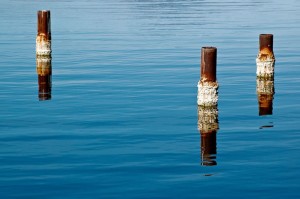So here I sit… working on yet another marina appraisal… and it dawns on me that there seems to be no universal standard for the marina slip count. Yes, it sounds really simple – just add them up either in person or from the marina map. Let’s explore why it’s just not that easy.
Simple Subtraction
So let’s say we have a 200 slip marina – physically, as it sits. That does not mean we have 200 rentable slips. Let’s subtract one for the pumpout slip, one for the fuel slip and one for the travel lift slip. We’re down to 197. The owner boats there, so subtract one more (we still include it as rentable slip, but it won’t show in the financial reports). Let’s say we have a boat repair operation. We might have 5 slips dedicated to boat repair, more or less. Now we’re down to 191. Let’s say we also have a used and/or new boat sales operation. When marinas are full, having slips reserved for new boats that you sell is often necessary to make the sale so subtract something for that (of course, that doesn’t apply in today’s economy). In the currently super-soft boat sales market, you can be sure that anyone in the boat sales business has an excessively large inventory of used boats they can’t move. You might subtract another 20 slips from the count so now we’re down to 171. So now what is rentable is 14.5 percent less than what is available. Marinas will vary in the slip count, but you get the idea.
The Slip Count Just Floats Away
 Want another permutation? You arrive in Winter and see that all the floating docks have been pulled from the water. They’re stacked along the side of a dry stack building. The owner says he has 200 slips. You have no choice but to trust that estimate because you can’t count them. Hopefully there is a marina map or a magnet board showing each of the slips so you can do the subtraction above.
Want another permutation? You arrive in Winter and see that all the floating docks have been pulled from the water. They’re stacked along the side of a dry stack building. The owner says he has 200 slips. You have no choice but to trust that estimate because you can’t count them. Hopefully there is a marina map or a magnet board showing each of the slips so you can do the subtraction above.
Voodoo
Looking out over our 200 slip marina, we see a bunch of rotten and deteriorated piles sitting out and away from the marina. They may be derelict and we know they should not be counted, but could they be grandfathered in? Would the permitting process be much easier? Would it go faster with floating docks instead of fixed docks? These are questions that need to be asked before we raise the dead and consider it as “upside potential”.
The Wildcard
I had a phone call last week from a prospective marina investor who was stuck with a problem. According to him, the parking ratio was about half of what was required under the zoning and he was concerned that the local government would find out and reduce the slip count. The township was none too partial to more impervious area at marinas thereby causing more of a potential flooding problem; the answer to that is gravel parking. The site really didn’t have much more area that could be used for parking anyway. My response was to look into whether it was grandfathered in from a change in the zoning ordinance. You can imagine his problem. If he asks this of a zoning official, he risks tipping them off and causing the problem he feared. I hope he treaded lightly on the topic and spoke only in general terms with the zoning official.
Let’s take a more common example. Does a marina already have all permits and approvals in place to expand? It may be nothing more than just adding more floating docks. After you consider the additional electrical wiring, water, etc., you can still get them in fairly quickly. This may not be applicable to today’s soft economy but in better times it could quickly increase the number of rentable slips.
Double Booking
I’ve appraised some “investment grade” marinas that get more income per slip than what shows on the contract. They are not being dishonest – they collect transient income from slips when a renter is gone for a certain period of time. I’ve seen 24 hours, 48 hours and 72 hours as the cutoff; anytime the boat is out of its slip for more than that period of time, it gets put into the transient rental pool. I like to think of them as “time and a half” slips. I wonder if there’s a “meter maid” present doing the time tracking.
The Approximation Factor
Many times when I’m conducting a slip rental survey, the response I get from marina managers is that they have a slip count that is a nice, round number. “We’ve got 200 slips”. There are two problems with this. First, the slip rental map or magnet booking board may show a different number. Second, there is the “truth” factor. By that I mean that some marina managers don’t want to reveal how many slips they really have. When they do, it’s a nice round number that may not be accurate. This is to deceive their competition since on the phone they may not want to believe I am gathering this information for an appraisal.
Functionally Obsolete Slips
Speaking of the term “rentable”, what do we do about functionally obsolete slips? There can be lots of places in a marina where a slip is technically rentable but practically impossible to rent. The two most common occurring examples of functionally obsolete slips are those on the entrance channel and those that are at the perpendicular junction of two docks (think of it as the two intersecting inside corners of the letter T). There are plenty more examples but the point has been made. These rentable slips require such a great discount that a whole bunch of them might not add up to the equivalent income of a single fully rentable slip. Or the boat may have to be so small that the income is a fraction of the average slip.
Not Too Deep, John
Here’s another example of a functionally obsolete slip – the dock that needs dredging. It may be too shallow there and only small shallow boats could be accommodated. Considering how long it takes to get a dredging permit, these slips also require much lower per-slip income projections. Technically they may be rentable but in many markets there is close to zero demand for them.
Conclusions
Not all slips are created equal. It only follows that the slip income projections should vary accordingly. Getting the slip count correct and projecting the income correctly given all the considerations above is the number one reason why I find key income discrepancies in marina appraisal reviews. Next time I’m in this position, I think I’ll just email a link to this blog. That solves my dilemma.

